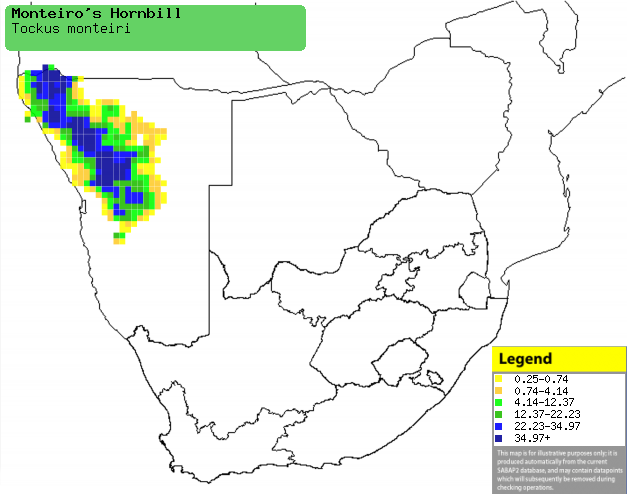|
Tockus monteiri (Monteiro's hornbill)
Monteirose neushoringvoŽl [Afrikaans]; KŰrwÍ
[Tswana]; Monteir-tok [Dutch]; Calao de Monteiro [French];
Monteirotoko [German]; Calau de Monteiro [Portuguese]
Life
> Eukaryotes
>
Opisthokonta
> Metazoa
(animals) > Bilateria > Deuterostomia >
Chordata > Craniata > Vertebrata (vertebrates) > Gnathostomata (jawed
vertebrates) > Teleostomi (teleost fish) > Osteichthyes (bony fish) > Class:
Sarcopterygii (lobe-finned fish) > Stegocephalia (terrestrial vertebrates) >
Tetrapoda (four-legged vertebrates) > Reptiliomorpha > Amniota >
Reptilia
(reptiles) > Romeriida > Diapsida > Archosauromorpha > Archosauria >
Dinosauria (dinosaurs) > Saurischia > Theropoda (bipedal predatory
dinosaurs) > Coelurosauria > Maniraptora > Aves (birds)
> Order: Bucerotiformes > Family:
Bucerotidae
The Monteiro's hornbill is near endemic to southern Africa,
occurring in Namibia and Angola. It lives in the driest habitats of any hornbill
in the world, preferring desert-like habitats with lots of rocky hills. It feeds
mostly on small animals, especially invertebrates, but it may resort to eating
seeds, fruit and bulbs in the dry season. It usually nests in tree or rock
cavities, although it regularly uses nest boxes. It lays 2-8, average 4-6 eggs,
which are incubated solely by the female, for 24-27 days. The female leaves the
nest when the oldest chick is roughly 22 days old, after which the oldest chicks
reseal the entrance. They eventually leave when they are 44-46 days old,
becoming fully independent a few days later.
Distribution and habitat
Occupies a small area from south-west Angola to north-west and central
Namibia. It occurs in the driest habitats of any hornbill
in the world, preferring desert-like habitats with lots of rocky hills; also in
large, flat areas with scattered trees.
|
 |
|
Distribution of Monteiro's hornbill in southern Africa,
based on statistical smoothing of the records from first SA Bird Atlas
Project (©
Animal Demography unit, University of
Cape Town; smoothing by Birgit Erni and Francesca Little). Colours range
from dark blue (most common) through to yellow (least common). |
Food
It feeds mostly on small animals, especially invertebrates,
hunting for them on the ground and in low shrubs. In the dry season it may resort to eating
seeds, fruit and bulbs as prey becomes more scarce. The following food items have been
recorded in its diet:
- Animals
- invertebrates
- vertebrates
- Plants
- seeds
- bulbs
- fruit
- flowers
Breeding
- It usually nests in natural tree or rock cavities, but it also regularly
uses nest boxes. The male searches for potential nesting sites, plugging
with mud the ones he thinks might be suitable to try to discourage other
cavity-nesters. Once he has a marked them he then presents them to the
female, who chooses which cavity to use. The inside of the nest is
sometimes lined with crushed millipedes, which are thought to serve as an
antibiotic to control parasites. The female then seals the entrance from the
inside, using faeces and material supplied by the male, leaving a small
slit through which the male passes food to her.
- Egg-laying season is from October-March, peaking from January-March,
about 1 month after the first heavy summer rains.
- It lays 2-8, usually 4-6 eggs, which are incubated solely by the female
for 24-27 days, fed by the male through the entrance slit.
- The female leaves the nest when the oldest chick is roughly 22 days old,
after which the oldest chicks reseal the entrance. They eventually leave
when they are 44-46 days old, becoming fully independent a few days later.
Threats
Not threatened, with an estimated population of 340 000-375 060. However, about 70% of its population live in commercial rangeland,
making them vulnerable to overgrazing.
References
-
Hockey PAR, Dean WRJ and Ryan PG (eds) 2005. Roberts -
Birds of southern Africa, VIIth ed. The Trustees of the John Voelcker
Bird Book Fund, Cape Town.
|
